Day 1 of a two day weekend of Bird Tours in North Norfolk. It was cloudy most of the day, but dry and mild and with light winds, before the sun came out later in the afternoon. We spent the day up on the coast, looking for spring migrants.
With the possibility that there could be some birds freshly arrived or on the move this morning, with the improvement in the weather after several cold and foggy days, we decided to spend the morning at Holkham and Burnham Overy Dunes.
As we drove up along Lady Anne’s Drive, we could see a couple of Egyptian Geese out on the grazing marshes and several Shoveler around the rushy edges of the pools. When we got out of the car, a more careful scan revealed a few Wigeon still lingering out on the grass (most have already departed on their way back to Russia for the breeding season) and a pair of Gadwall with them. There were also a couple of Oystercatchers and several Curlew. A pair of Lapwing were displaying further back.
Rather than heading out towards the beach, we turned west along the path before the pines. We could hear Chiffchaff and Blackcap singing deep in the trees along the first stretch, both early returning migrants. A Lesser Whitethroat started singing too, further back – it was probably just back from its African wintering grounds.
A Goldcrest started singing in the pines and we looked up to see it flitting around above us. We could hear a Treecreeper singing too, but it remained stubbornly elusive. Eventually we had a brief glimpse but it disappeared back into the pines before everyone could get onto it. A Great Spotted Woodpecker called from the trees too.
At Salts Hole there were a few Tufted Ducks and a single drake Teal out on the water. Another Chiffchaff was calling in the trees just beyond, and we followed it as it made its way quickly west on the edge of the trees, singing occasionally. Eventually it stopped to feed and we managed to get a better look at it. A Sedge Warbler was singing from the reeds as we scanned the grazing marshes from the gate. It popped up into some brambles briefly but dropped down before everyone could see it. Two Spoonbills flew past.
A couple of Marsh Harriers circled up out in the middle and then a Sparrowhawk appeared above our heads, over the path. From the boardwalk up to Washington Hide, we stopped to watch another pair of Marsh Harriers which were flying in and out of the reeds. The male made several short flights down to the edge of the marsh and then came back with sticks or bits of reed, presumably nest building.
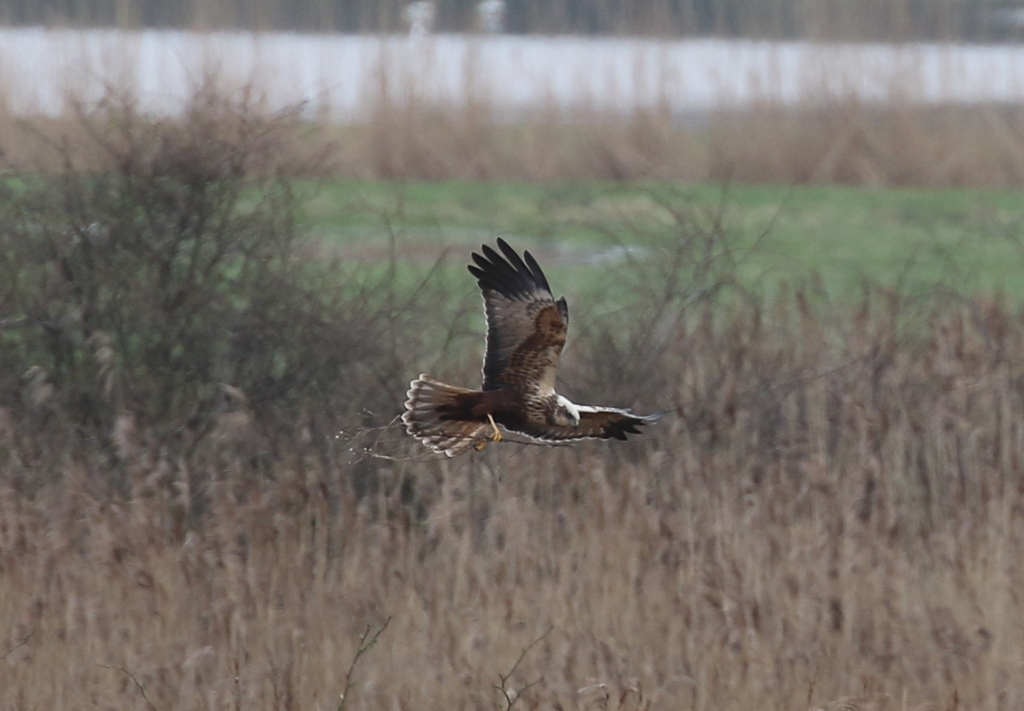
Continuing on our way west, we had nice views of a Sedge Warbler in the reeds by Meals House, which perched up more obligingly than the one we had seen earlier. Then it performed a song flight, fluttering up singing, before parachuting back down into the reeds out of view.
There were a few tits in the trees as we walked along. Then just before the crosstracks, we heard a Willow Warbler singing. It was in a bare deciduous tree on the edge of the pines and we had nice views of it as it alternately preened and sang, perched in the morning sunshine. We could see the lemon yellow wash to the supercilium. Then it started to feed actively, still stopping to sing from time to time.
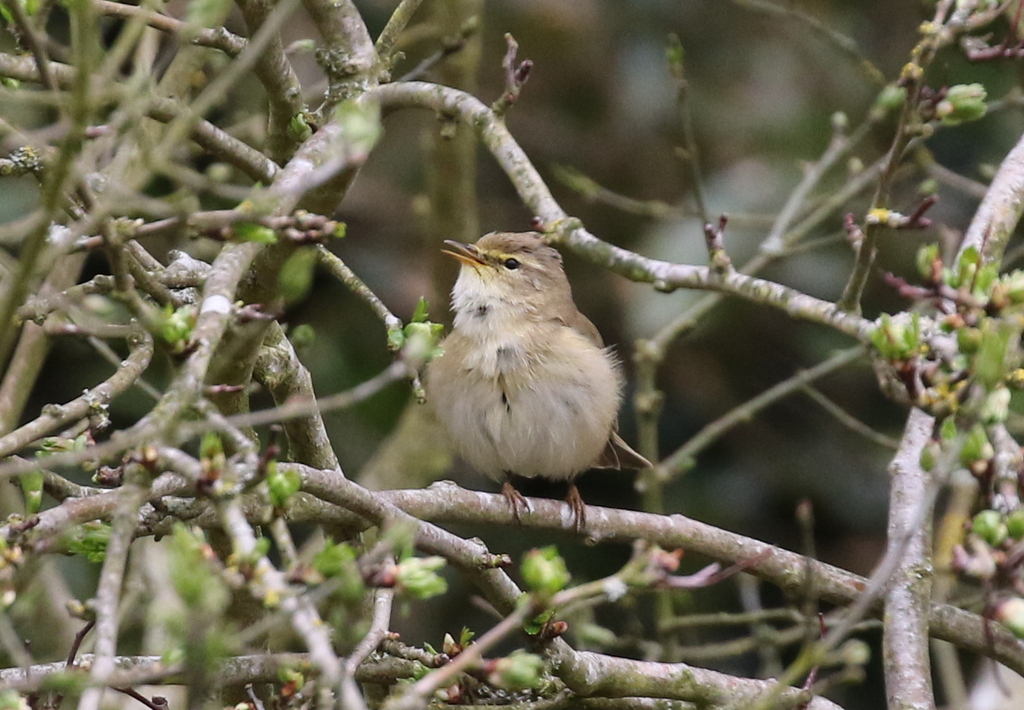
Another longer distance, trans-Saharan migrant, the Willow Warbler was very possibly freshly arrived back. The song is a lovely sweet descending scale, very different from the Chiffchaff, a real sign of spring when the Willow Warblers return.
At this point we received a message to say that some Ring Ouzels had been seen out in the dunes. So, rather than stopping at the hide, we continued straight on towards the end of the pines. We stopped to scan from the gate. A couple of Blackbirds flew out of the bushes, unfortunately lacking the white gorget of their upland cousins. We made our way on into the dunes.
It was rather quiet at first out here. There had apparently been quite a good passage of commoner migrants earlier, but it seemed to have slowed now. There were plenty of Meadow Pipits and Linnets in the bushes or down in the grass as we passed. A male Stonechat on top of a bush looked very smart.
The Ring Ouzels had apparently been with some other thrushes earlier, but we saw the Mistle Thrushes fly off west ahead of us, while a couple of Song Thrushes came up out of the dunes behind us. It was hard to tell which way the Ring Ouzels would most likely have gone, but we then received another message to say one had reappeared a short distance behind us, so we walked back to find it feeding out on the grass beyond the fence.
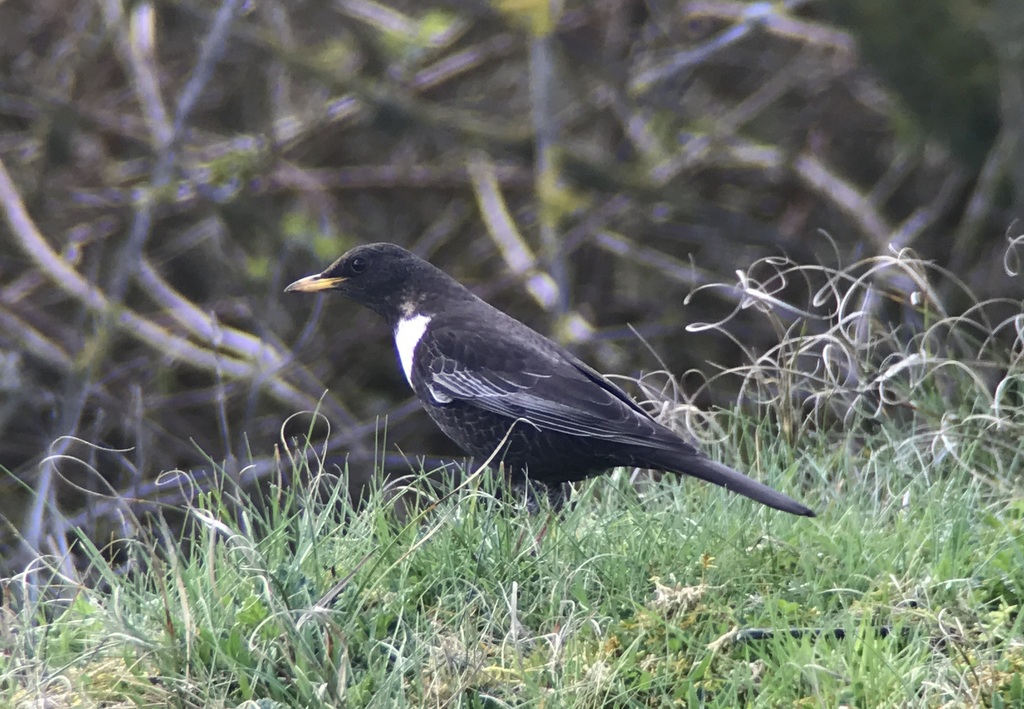
The Ring Ouzel was a smart male, with a bold white gorget. We had great views of it through the scope, as it fed out in the open. We could even see the silvery edges to the wing feathers. It would occasionally disappear back into the bushes, but kept coming out again onto the grass, before eventually moving further back. As we scanned the dunes further along, we spotted another Ring Ouzel perched in the top of a bush away to the west.
The Ring Ouzels are on their way from their wintering grounds in North Africa, back to their breeding grounds in Scandinavia and stop off here to feed. There had been six of them earlier, but we were more than happy with the views we had of these two. We decided to venture on a little further to see if we could find a Wheatear which had been seen along here earlier.
We continued on to the next open area in the dunes, but there was no sign of the Wheatear. It was getting very disturbed here now, with several people and families out walking their dogs. We didn’t have time to go all the way to the end of the dunes today, so we decided to head back east and have a look from Joe Jordan Hide on our way. A quick look out at the grazing marshes from the edge of the pines revealed a distant Great White Egret and a presumably feral Barnacle Goose with the Greylags. We could see three Spoonbills in the distance in the trees too.
As we climbed up to Joe Jordan Hide, we spotted a Great White Egret in one of the wet ditches right outside. As well as its large size, its long yellow bill gave it away. While we were watching it, we noticed another Great White Egret further back. This one had a black bill – their bills change colour when they are in breeding condition. Hopefully they will breed here again this year.
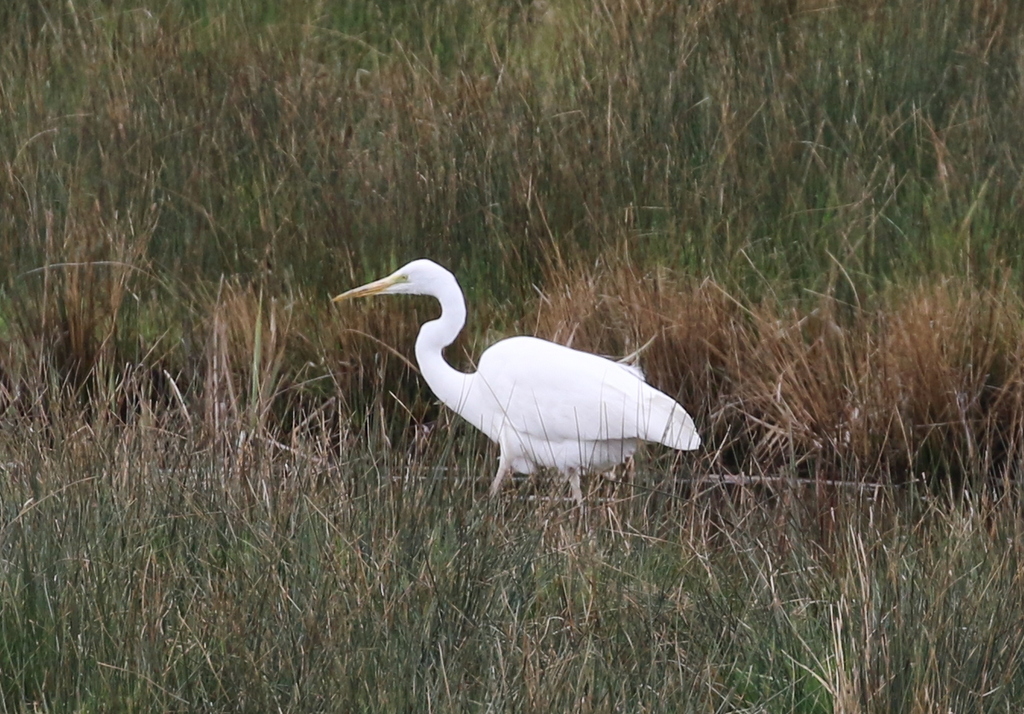
A few Little Egrets were coming in and out of the trees now too, which is good to see. The Little Egret population here was very badly hit by the cold weather earlier in the year. It will be interesting to see how many pairs breed here in 2018.
There was a lot of Spoonbill activity today. Several were down around the edges of the pool, bathing & preening. More were flying in and out from the trees, collecting nest material around the reedy margins of the water. We had a good view of them through the scope – the adults with their shaggy nuchal crests blowing in the breeze..
There were lots of Greylag Geese out on the grass around the old fort and looking carefully through we found two Pink-footed Geese with them. We could see they were smaller and darker, with a more delicate bill, dark with a pink bank. Most of the Pink-footed Geese which spent the winter here have gone already, back to Iceland for the breeding season, but a very small number normally over-summer here, typically sick or injured birds. One of the two today looked to have a damaged wing, presumably having been shot and winged over the winter.
Several Marsh Harriers were coming and going here too. A Red Kite circled up in the distance. While we were watching a dark Common Buzzard perched on a bush it suddenly took off and dropped sharply down onto the ground. It had caught something, and we watched as it flew off carrying it.
It was time to head back for lunch now. We made good use of the picnic tables at the top of Lady Anne’s Drive. It was nice weather to sit out and eat today, with the bonus of a couple of Spoonbills which flew over while we were there, one right over our heads so we got a very good look at its spoon-shaped bill.
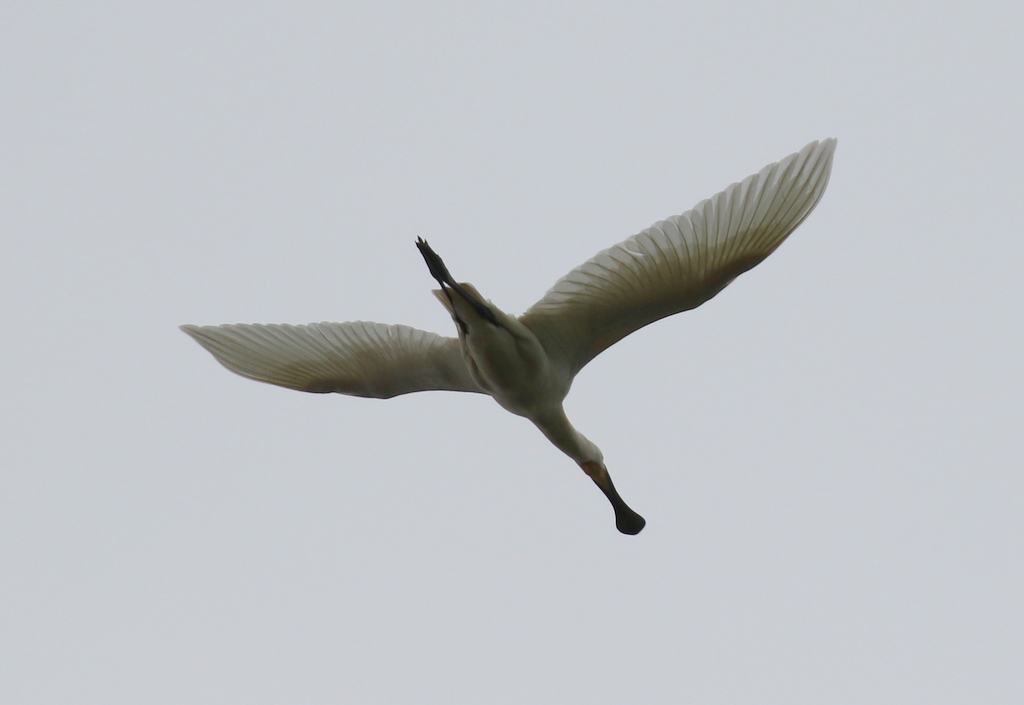
After lunch, we headed further west along the coast road. After a while, we turned inland to see if we could find some farmland birds. A pair of Red-legged Partridges and lots of Brown Hares were in the first fields. Then we spotted a big flock of Linnets lined up on the wires, and more in the hedge by the road, with a Kestrel perched nearby. A little further on, we found several Bramblings with a few Chaffinches in the hedge too. There is a wild bird seed crop growing here and the birds have been here all winter. It will soon be time for the Bramblings to leave.
We stopped again to check out another field where there is a seedy strip. As we scanned round, we spotted several Yellowhammers in the hedges, including a good number of lovely bright yellow males. We could see a distant Corn Bunting in the hedge over the far side too, so we walked a bit further down for a closer look.
When we stopped to scan again, we heard another Corn Bunting singing in the hedge just ahead of us, like a jangling bunch of keys. It was hard to see against the branches, very well camouflaged, but in the end we got a great look at it through the scope, perched up with the Yellowhammers.
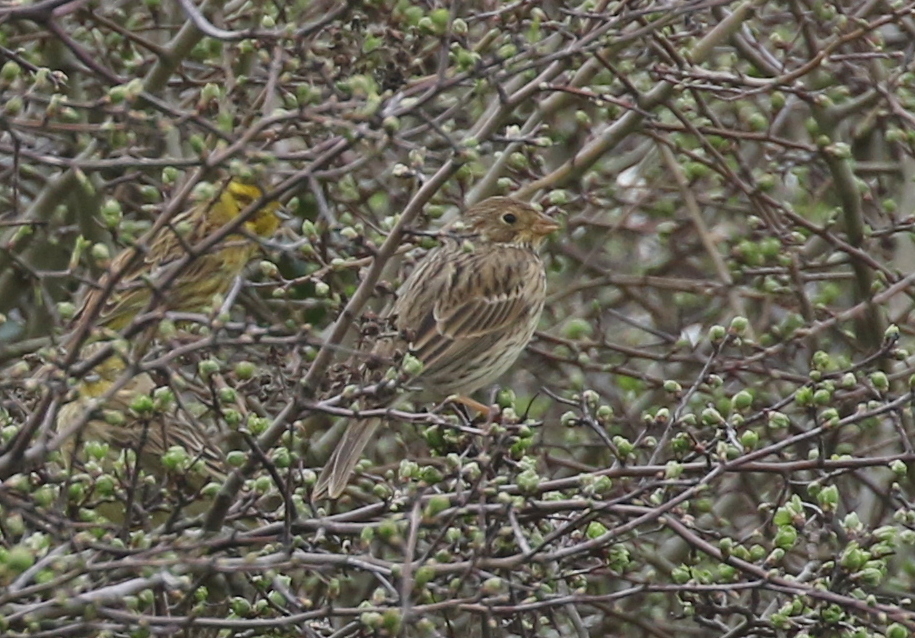
Our destination for the rest of the afternoon was Titchwell, so we swung round via Choseley on our way there. A pair of Grey Partridge were feeding in a winter wheat field by the road, the male keeping watch while the female concentrated on finding food.
As we got out of the car at Titchwell, we could hear Mediterranean Gulls calling overhead. Four Common Snipe flew over the car park, but disappeared behind the trees before everyone could get on to them. On the walk to the Visitor Centre, another Willow Warbler was singing in the sallows and, when we got there, a male Blackcap was singing in the tree right above us.
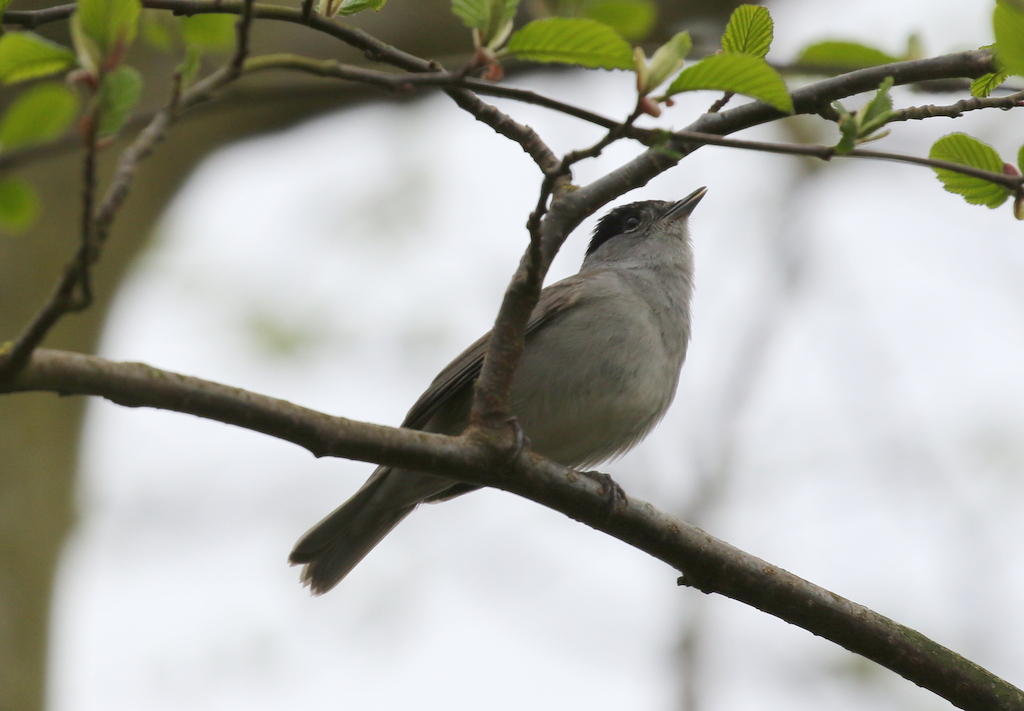
A quick look at the feeders revealed several Bramblings. At first a female appeared in the trees behind, then a young male, with a black-speckled head but rather dull orange breast and shoulders still. Finally a third Brambling appeared, a much brighter orange bird, presumably an adult male.

There have been a couple of Black Redstarts in the paddocks round by Patsy’s Reedbed for a few days, another early migrant just passing through here, so we went first to look for them. We couldn’t see any sign of them from the gate. The only bird of note on Patsy’s itself were a few Common Pochard, and a couple of Marsh Harriers were displaying just beyond, the male calling and tumbling down from high in the sky.
We walked over to the end of the paddocks and there was still no sign of the Black Redstart. It had just been seen on one of the stable, but had dropped down out of view, and it didn’t reappear while we waited. There had been some wagtails here too earlier, but there were just a couple of Pied Wagtails now, the Yellow Wagtail having flown off towards the freshmarsh. We decided to head back to the main path.
Walking out across the reserve, the Thornham grazing marsh was quiet and there was nothing singing in the reedbed today. A single Little Grebe was hiding in the channel through the reeds and a few Common Pochard and Tufted Ducks were on the reedbed pool. Then we heard a Yellow Wagtail calling over the edge of the saltmarsh in front of us and looked over to see it flying across. It came past us, back over the main path, and headed away back towards Patsy’s and the paddocks. Another nice spring migrant for the day’s list.
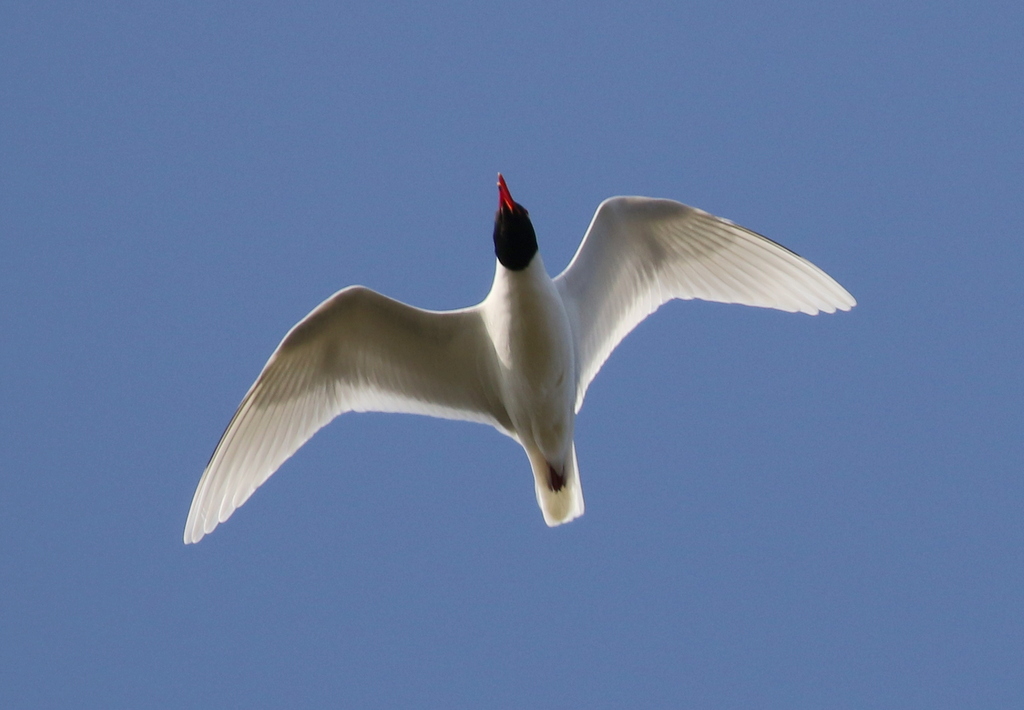
There were Mediterranean Gulls flying around calling non-stop, with lots of gulls flying back in from the fields inland. We could see the pure white wing-tips on the Mediterraean Gulls, which were translucent from below. The water levels on the Freshmarsh are much better now, much lower than they had been, but the islands seem to have been largely taken over by gulls. As well as loads of Black-headed and good numbers of Mediterranean, we found a few Common, Herring, Lesser Black-backed and Great Black-backed Gulls too.
With the improvement in the water levels, there are a few more waders back on here now. As well as the ubiquitous Avocets, there were a few Black-tailed Godwits, with many already moulting into their rusty breeding plumage. A lone Ruff was feeding around the edge of the nearest island, but there were mare further back, by the bank beyond Parrinder Hide, with a Redshank alongside providing a nice comparison.
There were still a few ducks on the freshmarsh, mainly Teal, although many have already departed back to their breeding grounds. The sun had come out now and the drake Teal looked particularly stunning in the late afternoon light.
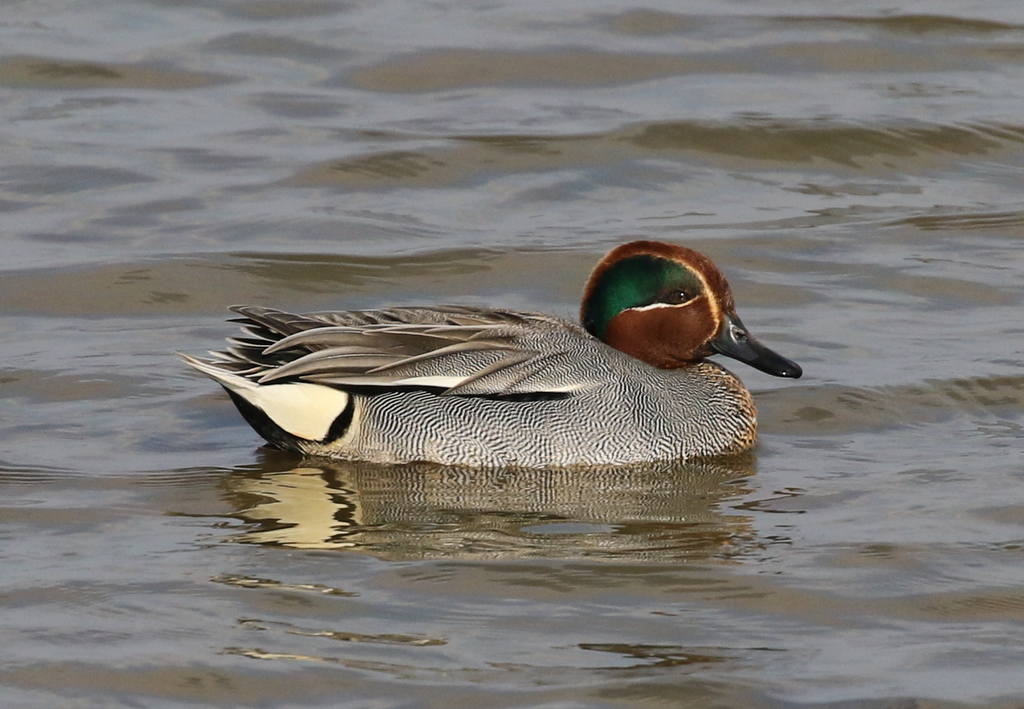
We had a quick look on Volunteer Marsh, but the tide was already coming in fast and the channel was flooded. There were a few Redshanks and Curlews out on the mud in the middle. We didn’t have time to head out to the beach today, but the tide would be in anyway, so we started to walk back.
As we got back to the reedbed, we heard a Bearded Tit call and watched as it flew in skimming the tops of the reeds and dropped down out of sight. A few seconds later, it flew again, back across the reedbed and disappeared once more. That is often all you see of the Bearded Tits but a little further along, we noticed some movement down low in the reeds at the back of the pools by the path and looked across to see a male Bearded Tit.
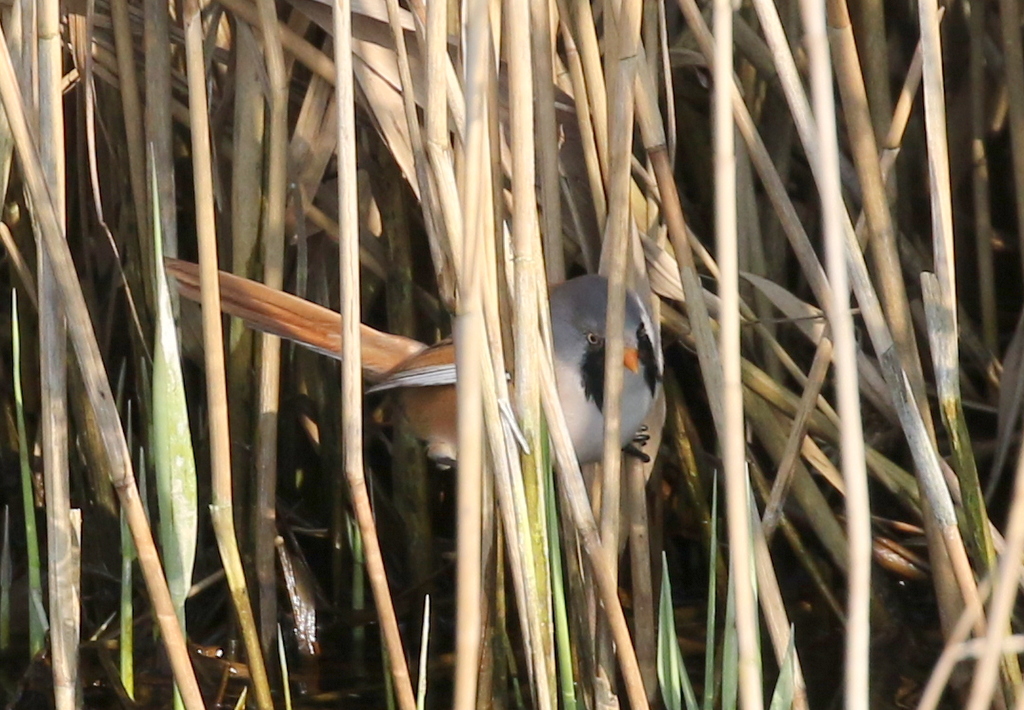
We watched the male Bearded Tit as it weaved its way in and out of the reeds, occasionally picking at the water surface or at the stems, presumably looking for insects. Then it flew across the water and disappeared into a thicker patch of reeds. As we waited to see if it might come out, a female Bearded Tit appeared in the reeds nearby.
Almost back to the trees, a ghostly pale shape flew in across the reeds and over the path. It was a Barn Owl. It headed round to the Thornham grazing marsh and started hunting over the rushy grass. We made our way back to where there is a gap in the trees and had geat views of it flying round. Eventually it dropped sharply down into the grass and when it finally flew up again we could see that it had caught a vole. It flew off with it in its talons, back the way it had come.

That would have been a very nice way to end, but back in the car park, we decided to have a quick look out towards the paddocks from the gates at the back. A quick scan of the stable revealed one of the Black Redstarts on the roof. It was the male, dark slate grey with a black face and an orange-red tail. It was perched, looking into the afternoon sun, presumably warming itself. A nice extra bonus to finish the day.
















